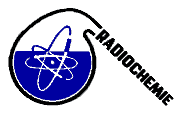Speaker
Dr
Dmitri Davydov
(Joint Institute for Power and Nuclear Research)
Description
Behaviour of radionuclides in such processes as sorption, ion-exchange, ultrafiltration, etc., that are used for removal of radionuclides from solution, is largely determined by their speciation in solution. The hydrolysis of metal ions in solution is particularly interesting in that respect, since most of the liquid radioactive wastes are aqueous solutions.
The following forms of metal ions (Mez+) occur in aqueous solution as the pH increases from acidic to basic conditions:
- hydrated cations (Me(H2O)z+)
- mononuclear hydroxocomplexes (Me(OH)qz-q+)
- polynuclear hydroxocomplexes (Mep(OH)qpz-q+)
- pseudocolloids
Each of the above forms possesses specific physico-chemical properties that can be effectively used for separation of radionuclides from solution. It has been shown that using the differences in ability of various metals to form hydroxocomplexes and the differences in behaviour of the above species in sorption and ultrafiltration processes it is possible to develop highly selective methods for extraction of radionuclides from solution, including anionic species.
Primary author
Dr
Dmitri Davydov
(Joint Institute for Power and Nuclear Research)
Co-author
Mr
Artsiom Radkevich
(Joint Institute for Power and Nuclear Research)

